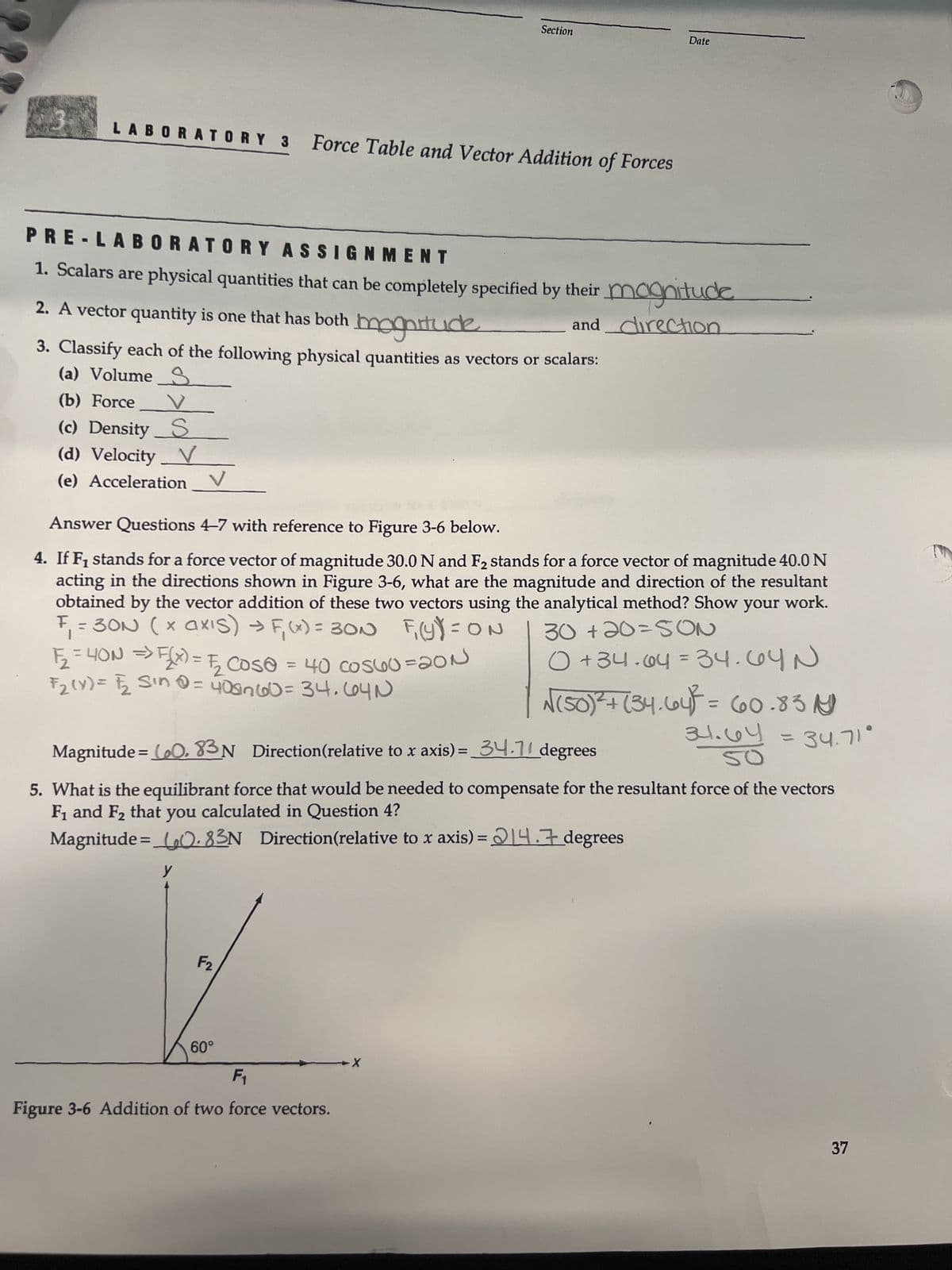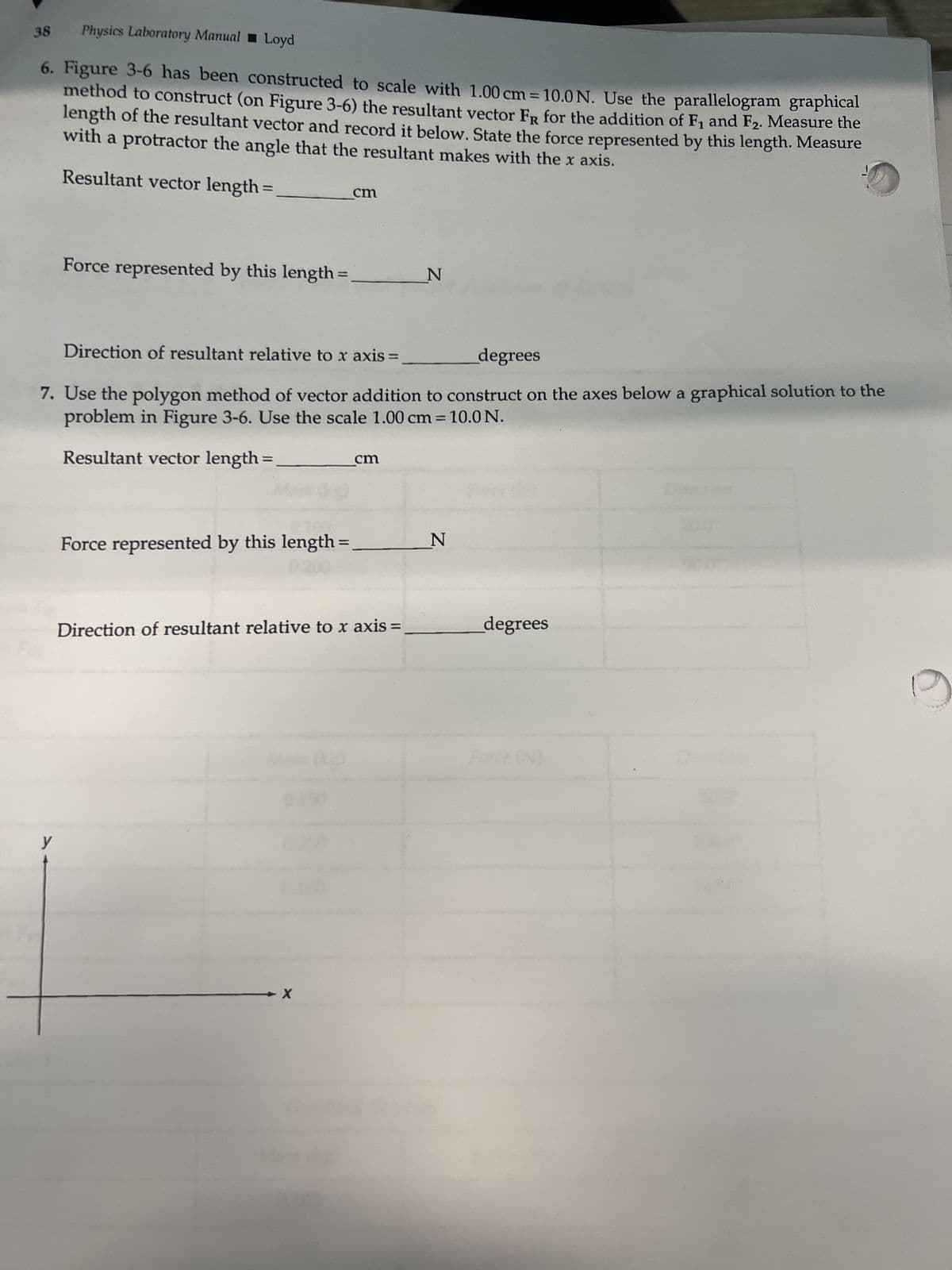38 Physics Laboratory Manual Loyd 6. Figure 3-6 has been constructed to scale with 1.00 cm= 10.0 N. Use the parallelogram graphical method to construct (on Figure 3-6) the resultant vector FR for the addition of F₁ and F₂. Measure the length of the resultant vector and record it below. State the force represented by this length. Measure with a protractor the angle that the resultant makes with the x axis. Resultant vector length= cm
38 Physics Laboratory Manual Loyd 6. Figure 3-6 has been constructed to scale with 1.00 cm= 10.0 N. Use the parallelogram graphical method to construct (on Figure 3-6) the resultant vector FR for the addition of F₁ and F₂. Measure the length of the resultant vector and record it below. State the force represented by this length. Measure with a protractor the angle that the resultant makes with the x axis. Resultant vector length= cm
Chapter2: Newton's Laws
Section: Chapter Questions
Problem 2MIO: In this chapter, you've encountered a large number of concepts it related to forces and motion....
Related questions
Topic Video
Question
Please help me with questions 6-7.
-Thanks !!!

Transcribed Image Text:3 LABORATORY 3 Force Table and Vector Addition of Forces
PRE-LABORATORY ASSIGNMENT
1. Scalars are physical quantities that can be completely specified by their magnitude
and direction
2. A vector quantity is one that has both magnitude
3. Classify each of the following physical quantities as vectors or scalars:
(a) Volume
(b) Force
(c) Density S
(d) Velocity V
(e) Acceleration
F₂2₂ = 4ON => F(X) = √₂2₂ Cos@ = 40 cosuo=20N
F₂ (Y) = F/₂ Sin 0 = 408760 = 34.604N
Answer Questions 4-7 with reference to Figure 3-6 below.
4. If F₁ stands for a force vector of magnitude 30.0 N and F₂ stands for a force vector of magnitude 40.0 N
acting in the directions shown in Figure 3-6, what are the magnitude and direction of the resultant
obtained by the vector addition of these two vectors using the analytical method? Show your work.
F
30+20=SON
= 30N (× axis) → F₁(x) = 30N F₁(Y) = ON
0 +34.64 = 34.64N
y
Section
F2
60°
Date
Magnitude = (₂0, 83N Direction (relative to x axis) = 34.11 degrees
5. What is the equilibrant force that would be needed to compensate for the resultant force of the vectors
F₁ and F₂ that you calculated in Question 4?
Magnitude=0.83N Direction(relative to x axis) = 14.7 degrees
F₁
Figure 3-6 Addition of two force vectors.
X
√(50)² + (34.64)³ = 660.83
34.64 = 34.71°
SO
37

Transcribed Image Text:38
Physics Laboratory Manual Loyd
6. Figure 3-6 has been constructed to scale with 1.00 cm = 10.0 N. Use the parallelogram graphical
method to construct (on Figure 3-6) the resultant vector FR for the addition of F₁ and F₂. Measure the
length of the resultant vector and record it below. State the force represented by this length. Measure
with a protractor the angle that the resultant makes with the x axis.
Resultant vector length=
Force represented by this length:
y
Direction of resultant relative to x axis
degrees
7. Use the polygon method of vector addition to construct on the axes below a graphical solution to the
problem in Figure 3-6. Use the scale 1.00 cm = 10.0 N.
Resultant vector length=
Force represented by this length=
0.200
cm
-X
cm
Direction of resultant relative to x axis
N
N
degrees
9
Expert Solution
This question has been solved!
Explore an expertly crafted, step-by-step solution for a thorough understanding of key concepts.
This is a popular solution!
Trending now
This is a popular solution!
Step by step
Solved in 2 steps with 2 images

Knowledge Booster
Learn more about
Need a deep-dive on the concept behind this application? Look no further. Learn more about this topic, physics and related others by exploring similar questions and additional content below.Recommended textbooks for you


Glencoe Physics: Principles and Problems, Student…
Physics
ISBN:
9780078807213
Author:
Paul W. Zitzewitz
Publisher:
Glencoe/McGraw-Hill

Physics for Scientists and Engineers: Foundations…
Physics
ISBN:
9781133939146
Author:
Katz, Debora M.
Publisher:
Cengage Learning


Glencoe Physics: Principles and Problems, Student…
Physics
ISBN:
9780078807213
Author:
Paul W. Zitzewitz
Publisher:
Glencoe/McGraw-Hill

Physics for Scientists and Engineers: Foundations…
Physics
ISBN:
9781133939146
Author:
Katz, Debora M.
Publisher:
Cengage Learning

College Physics
Physics
ISBN:
9781938168000
Author:
Paul Peter Urone, Roger Hinrichs
Publisher:
OpenStax College

College Physics
Physics
ISBN:
9781285737027
Author:
Raymond A. Serway, Chris Vuille
Publisher:
Cengage Learning

College Physics
Physics
ISBN:
9781305952300
Author:
Raymond A. Serway, Chris Vuille
Publisher:
Cengage Learning